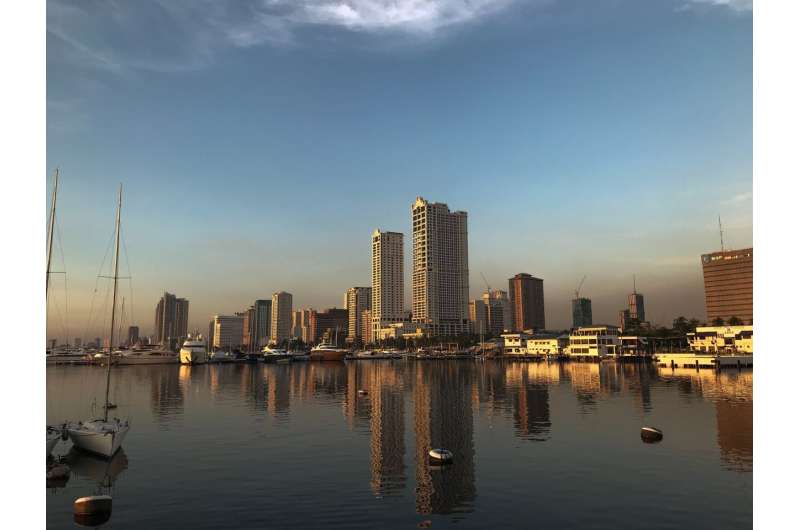Asia's coastal cities sinking faster than sea level-rise

Manila and several other coastal Asian cities are sinking faster than the rate of sea level rise, says a study that calls for strict regulatory measure to reduce groundwater extraction, identified as a major cause for land subsidence.
Since 1993, sea level rise has been happening at a rate of around three millimeters per year, according to the Intergovernmental Panel on Climate Change.
However, the Philippine capital saw land subsiding by more than 2 centimeters per year between 2015 and 2020, almost seven times faster than the average sea level rise, increasing the likelihood of flooding. The phenomenon of land sinking faster than sea level rise is more pronounced in Asian cities than elsewhere, says the study published in April in Geophysical Research Letters.
The study covered 99 coastal cities all over the world, 33 of which have areas or parts that have subsided by more than a centimeter per year. Researchers Pei-Chin Wu, Matt Wei and Steven D'Hondt from the Graduate School of Oceanography at the University of Rhode Island used satellite-based Interferometric Synthetic Aperture Radar to identify "fast-subsiding areas."
The study said excessive groundwater extraction is most likely the reason for the sinking of some areas in these cities—potentially affecting 59 million people. Past studies have cited rapid population increase, expanding industrial and agricultural production, absence of water treatment and poor water quality of available surface water due to pollution are among the major reasons for increasing reliance on groundwater.
"In most cities, part of the land is subsiding faster than sea level is rising," the study said. "If subsidence continues at present rates, these cities will be challenged by flooding much sooner than projected by sea level rise models. The most rapid subsidence is occurring in South, South-East, and East Asia. However, rapid subsidence is also happening in North America, Europe, Africa, and Australia."
Wei told SciDev.Net that land subsidence has lessened in Manila, though unregulated groundwater extraction may negate any gains.
"According to one study, Manila had subsided at 3 centimeters per year from 2003 to 2010. So, our observation of 2 centimeters per year between 2015 and 2020 is slower," Wei told SciDev.Net.
Wei and his fellow researchers say that their findings indicated that subsidence rates in Jakarta, Indonesia and Shanghai, China "have slowed significantly likely due to reduced groundwater extraction rates implemented as government regulations."
Between 1982 and 2010, land in Jakarta subsided by as much as 28 centimeters. In Shanghai, the land subsidence rate between 1990 and 2001 was 1.6 centimeters per year. From 2015 to 2020, however, subsidence fell and most drastically in Jakarta where it was 3 centimeters per year.
While looking for alternative sources of groundwater is a necessary solution, Manila needs to change how economic development is being pursued overall, says Rodrigo Narod Eco, a researcher at the Marine Science Institute at the University of the Philippines.
"I think the problem is fundamentally a development issue, where we have unabated conversion of landscapes and seascapes. For example, the subsiding areas in Manila City are mostly reclaimed land. Same as some other places too, like in Dagat-Dagatan, which was reclaimed during the Marcos dictatorship. Before that, it was a communal fishing ground," he told SciDev.Net.
"I think it can be possible to find alternative water sources, but we should still ask where the demand for water is coming from. Is it from commercial establishments, factories, plantations, fishponds? Even if we have alternative water sources, will it be available to households? Will the distribution be equitable?"
Meanwhile, the threat of land subsidence remains. Indonesia is being compelled to shift its capital to Nusantara from Jakarta where, as the study points out, places like Bekasi regency in the Indonesian capital are subsiding at two centimeters per year due to groundwater extraction.
Semarang, the capital of Indonesia's Central Java province, has seen land sinking by three centimeters per year as with Tianjin in China. This dwarfed the global mean sea level rise by almost 15 times, the study said.
Wei said the authorities in these coastal cities should be able to develop solutions that will address both the problems of land subsidence and sea-level rise. "The government should include coastal subsidence in their plan for sea level rise," he said.
More information: Pei‐Chin Wu et al, Subsidence in Coastal Cities Throughout the World Observed by InSAR, Geophysical Research Letters (2022). DOI: 10.1029/2022GL098477
Journal information: Geophysical Research Letters
Provided by SciDev.Net




















